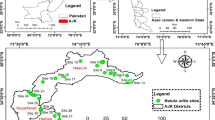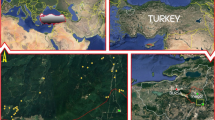Abstract
A field study was conducted in the Western Ghats of peninsular India to test the following two hypotheses: (1) lower floristic diversity for the cardamom hill reserves (CHR —a traditional agroforestry system of the tropics) compared to undisturbed evergreen forests and (2) a truncated vegetation structure for shade trees in the cardamom areas. The experimental sites involved three CHRs and an evergreen forest site.
The CHRs, regardless of their locations, were characterized by lower floristic diversity and density than the evergreen forest site. The undisturbed forest site at Ayyappancoil registered the highest floristic richness and diversity (Simpson's floristic diversity index, D=0.93), followed by the well-managed CHR site, suggesting that managerial interventions may have a strong bearing on the floristic diversity of CHRs. The current suite of species in the CHRs included both heliophilic as well as shade-tolerant components. However, dominant tree species, their density and relative abundance exhibited marked variations among the CHR sites, albeit about one-third of the species were common at all sites.
Stand physiognomy was characterized by the dominance of a single layer of trees in the CHRs, while the wet evergreen forest exhibited a multilayered canopy structure. Some of the lower height classes were poorly represented in the cardamom areas, whereas the evergreen forests depicted an inverse ‘J’ shaped height distribution pattern. Implicit in the truncated stand structure of the CHR is the poor regeneration status, due to systematic removal of the lower size classes.
Similar content being viewed by others
References
Abraham VA, Gopinathan KV, Padmanabhan V and Saranappa (1979) Deforestation and change of microclimatic conditions. Cardamom 12: 3–7
Cherian Antony (1977) Environmental ecology — an important factor in cardamom cultivation. Cardamom 9: 9–11
Cherian Antony (1986) Cardamom plantation industry in India. In: Srivastava HC, Vatsya B and Menon KKG (eds) Plantation Crops — Opportunities and Constraints, Vol 1, pp 245–262. Proc Symp on Plantation opportunities in India. Oxford & IBH Publishing Co. New Delhi/Bombay/Calcutta
CSIR (1976) The Wealth of India. Vol x. Council of Scientific and Industrial Research, New Delhi, 449 pp
Curtis JT and McIntosh RP (1950) The interrelations of certain analytic and synthetic phytosociolgical characters. Ecology 31: 434–455
FAO (1984) Intensive multiple use forest management in Kerala pp 76–77. Forestry Department, Food and Agriculture Organization. Rome
George SJ, Kumar, BM and Rajiv GR (1993) Nature of secondary succession in the abandonedEucalyptus plantations of Neyyar (Kerala) in peninsular India. Journal of Tropical Forest Science 5 (3): 372–386
KAU (1993) Package of Practices Recommendations — Crops 93. Directorate of Extension, Kerala Agricultural University, Vellanikkara, 237 pp
Kumar BM, George SJ and Chinnamani S (1994) Diversity, structure and standing stock of wood in the homegardens of Kerala in peninsular India. Agroforestry Systems 25: 243–262
Pascal JP (1988) Wet Evergreen Forest of the Western Ghats of India. Tome xxbis, Institut Francais de Pondichery, India, 343 pp
Simpson EH (1949) Measurement of diversity. Nature 163: 688
SSF (1992) Keys to Soil Taxonomy, 5th edition. SMSS Technical Monograph no 19, Soil Survey Staff, Blacksburg VA, 541 pp
Sorenson T (1948) A method of establishing groups of equal amplitude on similarity of species content. Biologiske Skrifter K. Danske Videnskbernes Selskab 5(4): 1–34
Spices Board (1991) Spice Statistics 1991. Spices Board, Kochi, Kerala, India
Whitmore TC (1983) Secondary succession from seed in tropical rain forest. Commonwealth Forestry Abstracts 44(12): 767–779
Author information
Authors and Affiliations
Rights and permissions
About this article
Cite this article
Kumar, B.M., Kumar, V.S. & Mathew, T. Floristic attributes of small cardamom (Elettaria cardamomum (L.) Maton) growing areas in the Western Ghats of peninsular India. Agroforest Syst 31, 275–289 (1995). https://doi.org/10.1007/BF00712079
Issue Date:
DOI: https://doi.org/10.1007/BF00712079




